IV
Wordsworth's lamb/ram fragment and the Adagio from Beethoven's E-minor quartet strongly rely on two aspects of expressive doubling that I have so far left implicit. First, expressive doubling is in some sense never mandatory; it is the trope of the possible, the extra, the unforeseen. A basic way to schematize the repetitions that structure works of art is to arrange them on a continuum that runs from the periodic to the uncanny or obsessive, from the measured to the fixated.[29] Expressive doublings seem to fall outside this scheme, at
[29] On obsessive repetition in Romantic works, see my Music and Poetry , 25–56; on uncanny repetition as a principle of narrative, see Peter Brooks, Reading for the Plot: Design and Intention in Narrative (New York, 1984), 3–37, 90–113.
least initially; they are presented as opportunities seized, as primary, not secondary or derived, gestures. This nonpareil quality, however, is put into question by means of deferred ambivalence, which often presses precisely in the direction of the uncanny. Hence Wordsworth's play with the meanings of "shadowy," Beethoven's sforzando attacks on his climactic diminished-seventh chords.
Second, expressive doublings typically proceed from low to high in the sphere of value; that is, they fulfill the masterplot of utopian esthetics. (The vertical order of value can be read suspiciously as a trace left by social and metaphysical hierarchies that are at odds with the utopian program, but that story is beyond the scope of this chapter.) "Low" and "high" are far from absolute terms, though; the low term may be strongly affirmative in its own right. Furthermore, some expressive doublings go in the other direction. This inverted form of the trope typically implies that the higher term has failed to master a transferred ambivalence and offers the lower term as an unorthodox alternative.
Beethoven's two-movement sonatas, which we are now ready to confront, pursue expressive doubling in both its utopian and inverted forms, and this in a consistent way. In the earlier pieces, Opp. 54 and 78, there is a descent from high to low: the second movement travesties the first. The contrary pattern informs the later two sonatas, Opp. 90 and 111, where the second movement transfigures the first. The sonatas of travesty keep to the same key and mode in each of their two movements, and in both cases the harmony of the second movement is unstable and even capricious in relation to the harmony of the first. The sonatas of transfiguration travel from a minor key in the first movement to the parallel major in the second, which is to say from harmonic tension to its resolution. And here the harmony of the first movements is restless, disquieting, while the harmony of the second movements is virtually static.
The conventional wisdom about these four works is that they constitute studies in contrast. Thus Op. 78 begins in lyric suspension and ends with fantastic wit, while Op. 111 begins with heroic struggle and ends in a meditative rapture. Like most conventional wisdom, this characterization is true up to a point—and it is beyond that point that things really get interesting. The second movement of each of these sonatas forms or incorporates an expressive doubling of some-
thing in the first movement. In the sonatas of travesty, the effect of the doubling is to break down a blindness or obstruction that appears, in retrospect, to set the first movements awry. The mood of the second movements is close to carnivalesque, in Mikhail Bakhtin's sense of the term.[30] This is music that disrupts hierarchies, celebrates change, and thrusts the physical energy of performance to the fore.
In the sonatas of transfiguration, the doublings patiently undo the underlying terms of a violence that fills the first movements with angular textures and brutal dissonances. The result resembles a process of healing, something akin to the "manifold repentance and purification" that Beethoven speaks of in the diary entry we considered earlier. The slow, transfiguring second movements seek a radical simplicity that can stand as the musical counterpart to inner peace, the acceptance of passing time, and inviolable joy.
Writing of Op. 54, Donald Tovey observes that its two movements "speak naively in their own characters" and that "Beethoven does not intrude with any indication that he could write a different kind of music with his fuller knowledge."[31] The first movement follows a simple ABA¢ B¢ A" design. The A sections elaborate on a placid little tune that Beethoven marks "In Tempo d'un Menuetto"; the tune's placidity corresponds to a marked harmonic inertia. The B sections shift the texture from melody and accompaniment to rigid, if not rigorous, imitative counterpoint. The first of them (mm. 25–57), after four bars on the dominant, is also quite volatile in harmony. These sections are outbursts of bearish, surly aggressiveness in feeling. In form, they are blatant send-ups of a two-part invention—in the shape of a perpetuum mobile .
As the movement proceeds, the A sections adorn their melody with increasingly lavish ornamentation; the coda rounds off this melodic enrichment by adding some enrichment in harmonic color. Meanwhile, the B section falls to pieces. Its second appearance (mm. 94–103) is so abbreviated that the earlier aggressiveness dwindles to
[30] Mikhail Bakhtin, Rabelais and His World , trans. Helene Iswolsky (Bloomington, Ind., 1984). Solomon (Beethoven 212–13) also sees a Bakhtinian element in Beethoven, here in connection with the festive character of the Seventh and Eighth Symphonies.
[31] Donald Francis Tovey, A Companion to Beethoven's Pianoforte Sonatas (London, 1931), 161.
mere bluster. Furthermore, the harmonic volatility heard earlier fails to rematerialize; after its dominant opening, the second B section merely jumps on the tonic and runs through an overlong, overinsistent half cadence. As a whole, then, the music subdues its rawboned aggressiveness by continuously enfranchising an opposing lyrical impulse.
Or does it? The movement sounds considerably patchier than its design should allow; its sections are as much jumbled together as dynamically opposed. The naiveté that Tovey speaks of is openly problematical. The expressive polarities of this music are conceived too crudely, contrasted too starkly. Something is wrong.
The second movement quickly suggests that the problem is an unwillingness to throw caution to the winds. Here again we find a perpetuum mobile —and this one really tries to live up to its name: it just cannot seem to stop. The movement is a virtual anthology of excess. Its binary form is grossly misproportioned, the second half being lengthened to accommodate a harmonic process that equals the melodic figuration in sprawling repetitiousness. Starting from the dominant of D minor, the harmony rotates (with some backing and filling) around an entire circle of fifths, continuing the rotation until it reaches the tonic (mm. 21–115).[32] The texture of the movement is just as single-minded: it consists of virtually nothing but two-part counterpoint. To put all these features together, the second movement constitutes an expansion of the first B section of the first movement—an expansion and a liberation. The mood is no longer aggressive but energetic and uninhibited, and this in decidedly physical terms. The contrapuntal texture is shot through with syncopated accents and with cross-rhythms hammered out on single pitches. (The cross-rhythms, I should add, hark back to the first movement, where the B sections use sforzandi to form cross-rhythmic passages.) From the perspective of this antinomian tour de force, the first movement appears in retrospect as genteel, almost priggish. The minuet theme seems to aim, not at curbing superfluous anger, but at preventing the outbreak of raw, untrammeled impulse, of carnivalesque noodling, key pounding, and nose thumbing.
[32] Ibid., 165–67.
Op. 54 is plainly an offhanded exercise, but its offhandedness is partly camouflage. To write music like the finale of the Seventh Symphony, which imports the carnivalesque into a great public genre, Beethoven imposes rigorous formal demands on himself. An offhanded little sonata, however, is something else again: a perfect excuse for turning from clumsy restraint to utterly unprincipled rowdiness.
The Sonata in F

The expressive force of this temporal difference depends on a parallel difference in texture. The first movement is a study in pure continuity, but a continuity that derives from the seamless weaving together of melodic fragments that are disjunct among themselves. Tovey suggests that this discordia concors "belong[s] to those things which we 'can understand perfectly so long as you don't explain.'"[34]
[33] Not everyone will hear this movement as a sonata form; on the account I am about to give, it might even be called a quasi-strophic hybrid. Nevertheless, its essential action conforms to the sonata principle: the recapitulation at the tonic of an extended passage first heard as a structural dissonance. I would outline the movement as follows; parts of the structure will concern us later on:
Exposition of first group only, ending on dominant (mm. 1–31).
Full exposition (mm. 32–88):
first group with slight variation (mm. 32–50); overlapping with
second group at VI and vi, beginning on V/VI (mm. 51–73);
closing passage on Aug 6/IV (mm. 74–88).
Recapitulation (mm. 89–149):
first group of full exposition at IV, ending on V (mm. 89–109);
second group at tonic, beginning on dominant (mm. 110–32);
closing passage on Aug 6/I (mm. 133–49).
Deferred recapitulation of part of first group at tonic (mm. 150–61), extended and merging into coda (to end).
[34] Tovey, A Companion , 178.
Beethoven's secret, however, is to let different strands of continuity overlap throughout the movement. Prominent among these are running sixteenth-note figuration, the rhythmic figure

Beethoven uses these sources of continuity to weave a kind of web. The sixteenth notes act as a principle of large-scale association, while the primary rhythmic figure establishes a series of tiny, immediately perceptible points of connection. As Example 2 suggests, the motives a and b act in both these ways on different structural levels. The result, thanks to a relaxed pace and a lack of dramatic incident, is a glittering, dreamy texture, a condition of lyric suspension. Even the development yields to the spell: short and quiet, it is little more than a group of sequences aimed at the dominant.
All in all, this music has the sound and movement of an idyll—the very idyll that Schiller had demanded from the Romantic artist. As Mikhail Bakhtin has suggested, the idyll as a narrative form became increasingly important after the mid-eighteenth century, when Rousseau and others found that its elements could "provide material for constituting an isolated individual consciousness, and from the point of view of such a consciousness . . . act as forces that can heal, purify, and reassure it."[35] According to Bakhtin, idyllic narrative is marked by a specific spatial-temporal profile (or "chronotope"). Among its major temporal features are continuity, cyclical movement, and the absence of rigid boundaries: precisely the major features of the movement before us.
[35] Mikhail Bakhtin, The Dialogic Imagination , trans. Caryl Emerson and Michael Holquist (Austin, Tex., 1981), 231.
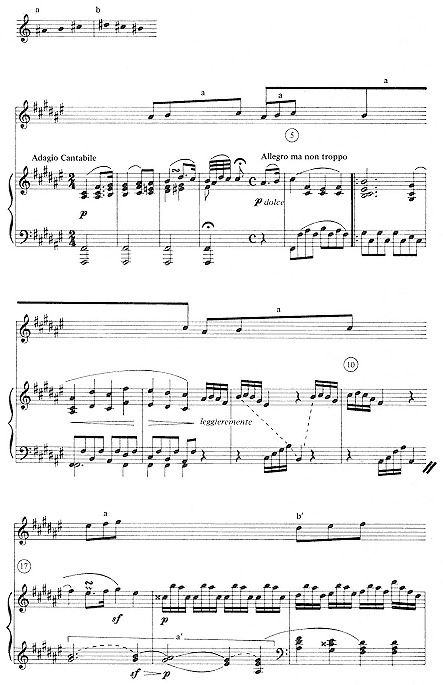
Example 2
Beethoven, Piano Sonata in F

Opening Motives a and b invert each other both
directionally and intervalically. Simple directional
inversions, used transitionally, are marked a ' and b '.
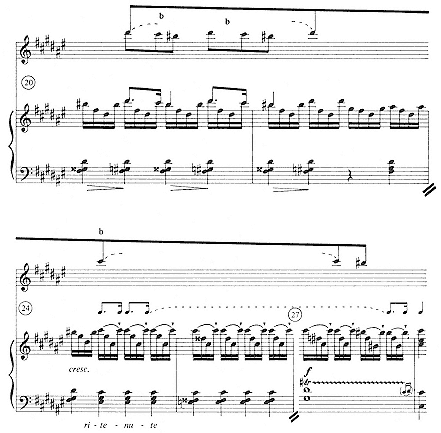
Example 2
The movement also reproduces a further feature of the idyllic chronotope, the figure of growth or germination. Beethoven begins Op. 78 with a brief cantabile introduction. As Example 2 shows, this apparently fragmentary passage adumbrates both the primary rhythmic figure and the primary interval set. These elements, however, are not yet singled out, not yet differentiated within the musical texture. The introduction "contains" the whole movement, but contains it in embryo. The movement proper begins with the first gesture of differentiation: the coalescence of the rhythmic figure and motive a .
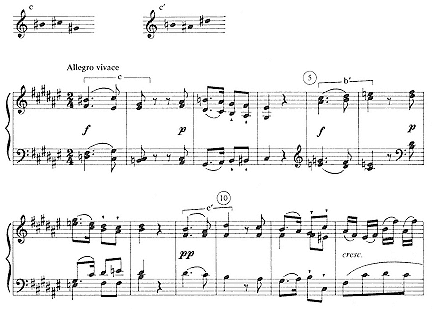
Example 3
Beethoven, Piano Sonata in F

The introduction, however, also adds a certain quality of longing to the music, as if to suggest that the idyll is finally no more than a beautiful fiction. This effect derives partly from the tonic pedal deep in the bass, which forms gentle dissonances on the downbeats of mm. 2–4, but there is also a more explicit resonance. As Erich Leinsdorf observes, the introduction unobtrusively alludes to Beethoven's nearly contemporary setting of Mignon's "Kennst du das Land?" from Wilhelm Meister , with its own idyllic, indeed paradisal, longings.[36]
The second movement turns abruptly away from idyllic time to a mode full of energy and foreshortening. The music is again dominated by melodic fragments, but now the fragments fail to interlock—they repeal continuity at every turn. Or better: they celebrate the mercurial, slightly malicious pleasures of discontinuity. The first theme is unabashedly a jumble: three parallel but disjointed statements of a melodic fragment disjointed in itself (Example 3). For
[36] Erich Leinsdorf, The Composer's Advocate: A Radical Orthodoxy for Musicians (New Haven, 1981), 10.
our purposes, the most telling effect of this material is to parody the devices that hold the first movement together. The rhythmic substance of the theme derives from the primary figure

Fragmentation continues as the theme breaks down into a scurrying, spiky figuration that will prove to dominate the movement. Pairs of rising or falling sixteenth notes run up and down the keyboard, saw-toothed versions of the running sixteenth notes of the first movement. As in Op. 54, a decidedly physical, performative energy impels this music. Five times the spiky episode takes flight unaccompanied; in each case the episode begins with alternating right- and left-hand attacks on a series of identical two-note figures, so that the separation between the figures becomes an extension of the separation between the hands. Two of the passages also go on to demand some rapid-fire hand-crossing once the alternating attacks proceed between different figures. If the first movement glitters, this one spurts.
And as with melody, so here with structure. The exposition (see note 33) begins with an augmented sixth and proceeds to cadences on V and IV before reaching a cadence on I. This nonchalant treatment of the tonic is later elaborated on a larger scale with cheerfully vertiginous results. The close of the exposition (mm. 74–88) harps on the augmented sixth of IV; the recapitulation, which follows directly, takes this chord as a pretext to repeat the whole first group in the subdominant. Only at the end of the movement does the first group—and then only a piece of it—return in the tonic.
The sum of all these centrifugal forces is an essay in anarchic charm. Beethoven uses the second movement of Op. 78 to withdraw from the imaginary satisfactions, the implicitly unavailing longings, of the first. Not that the second devalues the first, as it does in Op. 54. Instead, the music exchanges an idyllic ideal for a less rarefied alternative: the haven of Romantic irony, in which the artist can savor the dissolution of a beautiful daydream no less than the daydream itself. This finale is a foray into that "poetical character"
which, according to Keats, "has no character—it enjoys light and shade; it lives in gusto, be it foul or fair, high or low."[37] On this reading, we might expect the sonata to end exactly as it does: at the furthest possible remove from its evocative opening, with an unexpected frolic of the spiky figuration.
The Sonata in E Minor, Op. 90, reverses the temporal pattern of Op. 78, so that the idyll of its expansive finale transfigures the compressed drama that precedes it. The first movement opens with a strong internal conflict as its first theme splits into a rough declamation (mm. 1–8, itself divided into a forte/piano dialogue) and a flowing response in lyrical counterpoint (mm. 8–16). Classical sonata form usually reserves a cantabile answer to a more vigorous opening theme until the second theme initiates a swing to the dominant. By encapsulating the melodic drama of the form in its opening gesture, Beethoven suggests that the formal drama derives from something more primary, more subjective, and more difficult to control. Not surprisingly, the movement as a whole continually echoes its troubled opening; it proliferates into a wide variety of abruptly juxtaposed textures amid considerable agitation. The harmony is restless throughout, its free-floating tensions crowned by the use of the dominant minor for the decidedly noncantabile second theme. The movement does end quietly, dying away in a series of echo effects, but in terms haunted by latent unease. The closing passage is a repetition of the last eight measures of the first theme: music that leads in the exposition and recapitulation to a painfully bright outburst that thrusts the harmony from the tonic to the submediant. The prolonged rest that ends the movement thus tingles with an unsettled air of anticipation. The remembered sound of the submediant seems to loom faintly beyond the finality of the cadence.
The E-major finale is as serene a movement as Beethoven ever wrote, a rondo that traces idyllic circles by luxuriating in a double statement of its songful main theme, not just the first time the theme is heard, but every time. The instabilities and textural collisions of the first movement all but disappear in the enraptured suavity of this music. A rippling accompaniment runs through nearly every mea-
[37] Letter to Richard Woodhouse, October 27, 1818; in The Letters of John Keats , ed. Maurice B. Forman, 4th ed. (Oxford, 1952).
sure, creating an aura of continuity even more palpable than its counterpart in Op. 78. Disruptive forces are admitted only once, in the central episode, where the unsettled accents of the first movement are revived and smoothed away. The episode begins by darkening unexpectedly. E major reverts to the earlier E minor (m. 103), which turns with a crescendo to the dominant of C, that is, V/VI. Then a broadly flowing theme, heard earlier during the first episode, returns four times in every possible form of E-major/minor submediant harmony (C, c, c


The second movement is now free to fulfill, by expressive doubling, the thwarted lyrical aspirations of the first. Just before the final statement of the rondo theme, Beethoven returns to the dominant of C and proceeds to the home dominant through ten measures of lyrical counterpoint (mm. 212–21). The same texture recurs just before the coda in a more crystalline version (mm. 266–75). The affinity between these passages—call them A and B—and mm. 8–16 of the first movement is striking enough in general terms, but it is not merely general. All three passages make use of common tones to link symmetrical phrase units in the upper voice (Example 4; passage A partly substitutes linking octaves to give B a more consummatory role). Heard in retrospect against passages A and B, the lyrical counterpoint of the first movement becomes a premonitory venture into the heart of idyllic time. A and B are the only extended episodes in the finale to suspend the rippling accompaniment. The result, however, is not a break in continuity but an enrichment of it; the counterpoint takes its impetus from a portion of the rondo theme and moves at the same pace as the theme. Stripped of embellishment, this melodic motion seems to embody the movement of idyllic time in its pristine form. The effect is particularly strong in passage B, which answers the movement to the dominant traced by both the counterpoint of the first movement and passage A. When B closes on a full cadence to the tonic, the E major that emerges is untouched by the tensions that fringe the earlier E minor. As the cadence sounds, the first phrase of
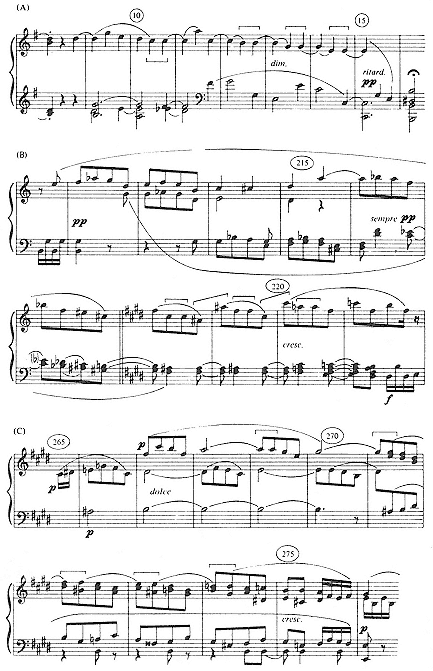
Example 4
Beethoven, Piano Sonata in E Minor, Op. 90. (A) First movement,
lyrical counterpoint. (B) Second movement, first lyrical
counterpoint (Passage A). (C) Second movement, second
lyrical counterpoint (Passage B).
the rondo theme returns, lingers, then yields to a lyrical codetta that brings the sonata to an end in undisturbed possession of its happiness.
And Op. 111? We can continue to speak of drama and idyll in this work, but only if we greatly enlarge the force of the terms. Commenting on the "incisive reworking of idyllic time and idyllic matrices" in Rousseau and his followers, Bakhtin observes that "the basic elements of the ancient complex—nature, love, the family and childbearing, death—are isolated and undergo sublimation at a higher philosophical level, where they are treated more or less as forms of the great, eternal, wise force of earthly life."[38] Bakhtin's remarks transfer remarkably well to Op. 111, with the qualification that Beethoven's sublimation is religious or quasi-religious as well as secular.
To review the well-known contour of the work: Beethoven begins by writing the fullest heroic movement of his late period, comparable in its turbulent intensity only to the finale of the Quartet in C

The expressive doubling between these two movements is all but subliminal. It does not depend on the recurrence of musical textures like its counterparts in the three earlier sonatas, but on underlying affinities between textures as different as Beethoven can make them. These affinities have many sources, but the one about which the
[38] Bakhtin, Dialogic Imagination , 230.
[39] Martin Cooper, Beethoven: The Last Decade (London, 1970), 200.
others ultimately revolve is a referential sonority built from the strongest dissonance known to Classical harmony: the diminished-seventh chord.
In Op. 111, Beethoven takes the unprecedented step of giving primary structural value not just to a dissonance, but to a chromatically saturated aggregate consisting of all possible forms of the dissonance. In this case, of course, that means three forms, which I will arbitrarily designate as Dm7-1, -2, and -3. As Charles Rosen has shown, the Maestoso introduction to the sonata can be reduced to a series of three resolutions: Dm7-1 to the dominant, Dm7-2 to the tonic major, and Dm7-3 to the subdominant (minor).[40] The introduction closes with hints of a cyclical pattern, returning to the Dm7-1/V nexus before closing into the main Allegro. (The hint is dropped until the movement is nearly over—as we shall see.) Rosen describes the significance of what happens next:
The main theme of the Allegro that follows is derived from these diminished-sevenths and their resolutions . . . [which also] provide a basis for [the] development, [where] the order of the chords is . . . always that of the introduction. The expressive significance of these chords needs no comment; they color most of the piece, occur with extreme violence at every important climax, and supply the dynamic impulse for most of the harmonic transformations.[41]
By building on so radically dissonant a foundation, Beethoven tests the limits of Classical sonata form. At the heart of the form is the resolution of structural dissonance. The effect of the diminished-seventh aggregate in the first movement of Op. 111 is to extend structural dissonance across a hierarchy of structural levels.[42] To resolve this extended dissonance is to venture the claim that no dissonance, musical or otherwise, is too extreme to be mastered. In this instance, the fulcrum of mastery is order: the fixed order of the diminished-seventh aggregate and its resolutions, an order always
[40] Charles Rosen, The Classical Style: Haydn, Mozart, Beethoven (New York, 1972), 442–43. Robert K. Wallace (Emily Brontë and Beethoven [Athens, Ga., 1986], 109–15) also follows Rosen in emphasizing the role of diminished-seventh sonority in this movement.
[41] Rosen, Classical Style , 444.
[42] My thanks to Richard Swift for this point.
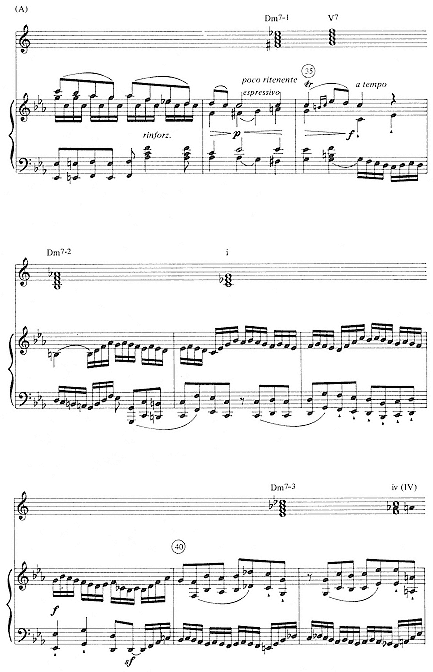
Example 5
Beethoven, Piano Sonata in C Minor, Op. 111. Allegro.
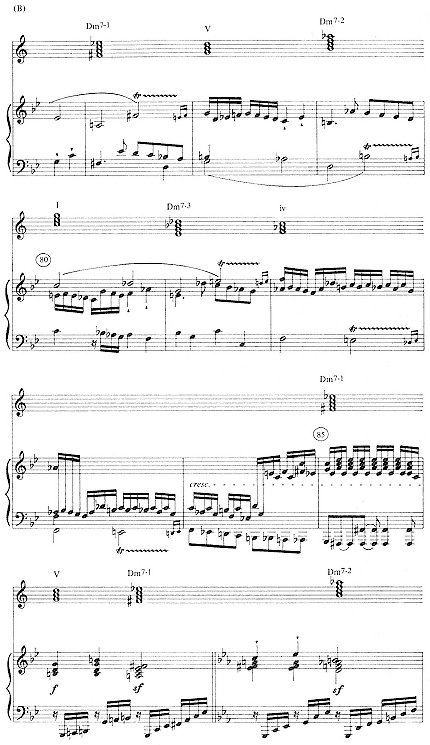
Example 5
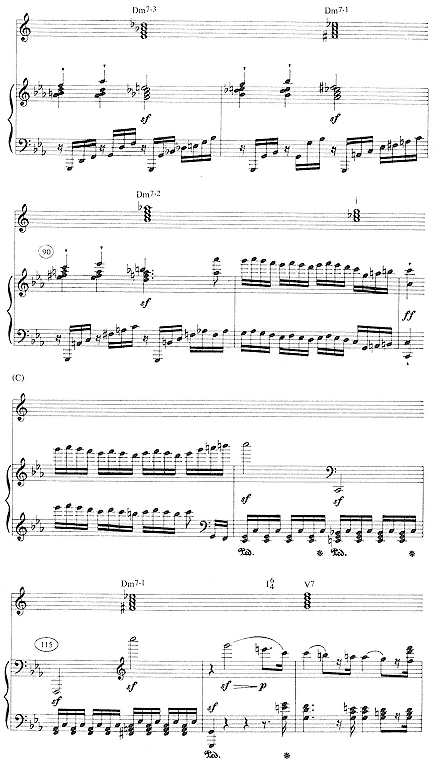
Example 5
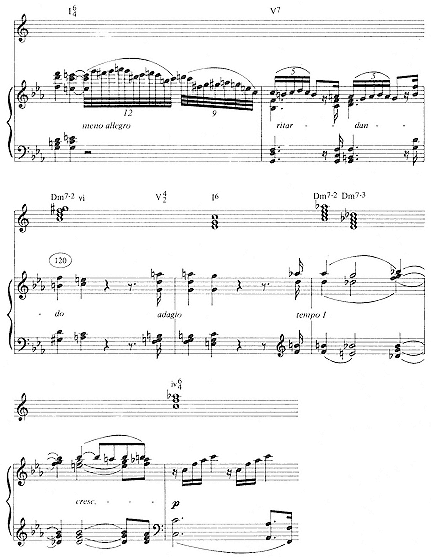
Example 5
present as a discipline even when it is concretized in fragments. Heroic discipline, however, is not always easy to tell apart from uncompromising rigidity. For all its formidable integrity, this music may be self-defeating in the end. Hence one of its most striking features: its extremely, even grotesquely, emphatic gestures of internal closure (Example 5c).
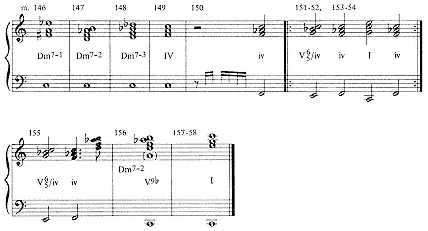
Example 6
Beethoven, Piano Sonata in C Minor, Op. 111. Closing measures of Allegro: outline.
As to final closure, the Allegro seeks it in a culminating gesture of mastery that is deliberately astonishing—at once overwhelming and not quite credible. The concluding measures do three things at once: (1) they return to the resolution structure of the introduction; (2) they detach the sonorities of the resolutions (V, I, and iv) from the hegemony of the diminished-seventh aggregate; and (3) they state these sonorities in a new order, corresponding to the unfulfilled cyclical thrust that led from the introduction to the Allegro. The process is outlined in Example 6. It begins with the diminished-seventh aggregate, which enters forcefully over a tonic pedal and dies away onto the subdominant major (mm. 146–49). The subdominant minor then splits off on its own, assumes dramatic prominence, and generates a cadence to the tonic major through Dm7-2, which is now reinterpreted as a dominant. Thus the last tonic resolution in the movement reenacts the first—a piece of unfinished business;[43] the tonic major claims to quell the diminished-seventh aggregate, which the minor could only perpetuate. In this context, all the C-minor music and its extended derivatives appear to form little more than an exaggerated episode—what the next chapter will identify as a dis-
[43] I steal this term from Edward T. Cone, who explores its implications in his "Schubert's Unfinished Business," Nineteenth Century Music 7 (1984): 222–32.
ruptive interlude. That the "interlude" amounts to just about the whole movement is, Beethoven seems to suggest, a mere detail.
The movement that follows is intended to make sense of that suggestion. Its variations seek to justify the (re)turn to the tonic major that closes the Allegro by expanding C major into a sonority so luminous and all-pervasive that it mirrors the return to the "elevated and pure source" evoked in Beethoven's 1815 diary entry. Behind this effort stands the traditional metaphor of the ideal mind or soul as harmonious music, as codified for the Middle Ages and beyond by Boethius. Boethius envisioned a musica humana : a perfect concord of body and spirit, reason and passion, formed by analogy to the musica mundana , the inaudible perfect harmony that governs the heavenly spheres.[44] Beethoven's variations set out to form a sustained elaboration of consonant harmonies, an "undisturbed song of pure concent," that can realize the figure of musica humana in actual sound: the musica instrumentalis that forms the third term in Boethius's system.
Beethoven may even have had Boethius specifically in mind. He composed Op. 111 while also working on the Missa Solemnis , and his work on the mass involved intensive research into the theory and practice of early music. As part of this project, he had a friend draw up abstracts from Boethius and other ancient authors.[45] Later, while at work on the Agnus Dei of the mass, he scribbled a note to himself: "Strength of the sentiments of inner peace above all."[46]
The same value governs the two-part form of Op. 111. At first, the Adagio seems simply to turn its back on the harshness of the Allegro; the contrast between the two movements could not be more extreme. Before long, however, denial turns to recognition and recognition to
[44] "Boethius," The New Grove Dictionary of Music and Musicians , ed. Stanley Sadie (London, 1980), 2:844–45. See also John Hollander, The Untuning of the Sky: Ideas of Music in English Poetry, 1500–1700 (Princeton, 1961), 3–51; and James Anderson Winn, Unsuspected Eloquence: A History of the Relations Between Poetry and Music (New Haven, 1981), 30–73. For an account of the workings of this conceptual matrix in another major work of Viennese Classicism, see my "Music and Representation: The Instance of Haydn's Creation ," in Text and Music: Critical Inquiries , ed. Steven Paul Scher (Cambridge, forthcoming).
[45] See Warren Kirkendale, "New Roads to Old Ideas in Beethoven's Missa Solemnis ," in The Creative World of Beethoven , ed. Paul Henry Lang (New York, 1971), 163–99.
[46] Ibid., 175n .
reenactment. The heroic discontinuities of the Allegro gradually submit to transfiguration by expressive doubling.
The recurrence of the diminished-seventh aggregate and its resolutions gives the first movement a basic periodic rhythm that cuts across the harmonic divisions of sonata form. The substance of this rhythm, however, is a series of disturbances, ruptures, shocks. Ruled by agitated fugal textures, the music repeats its fundamental pattern, its Schoenbergian Grundgestalt , in irregular surges, now sweeping, now constricted (Example 5a–c). No aspect of the music is left untouched by this process. The basic tempo of the Allegro is continually retarded and released; huge melodic leaps punctuate the texture at points of climax and closure; violent sforzandi on strong beats disrupt the metrical pulse in the act of affirming it. The unfolding of musical time, like the dissonant matrix that impels it, is at once unyielding and unstable.
In the wake of such turbulence, the limpid periodic rhythm of the slow movement, perfectly symmetrical in the theme, perfectly changeless through four variations, is extraordinarily consoling. The profoundly peaceful theme—Beethoven calls it an arietta, a little song—represents Classical binary form at its most transparent. Two eight-bar strains unfold in four-bar periods; each strain is repeated in the pattern AABB. The variations keep strictly to these proportions, and to much else. The underlying tempo of the arietta is never varied, even in passing—not a single accelerando or ritardando occurs in the whole movement—and the unvaried beat always falls three to a measure. The only dynamic element is the melodic motion, which continually quickens as the beat subdivides further with each variation. Countless sets of merely ornamental variations do the same thing, though rarely within such an austere framework. As Tovey liked to observe, however, Beethoven (like Bach) was never more serious than when he wrote such ornamentation, as the slow movements of the Appassionata Sonata, the Violin Concerto, the Archduke Trio, and the Ninth Symphony all attest.[47] In Op. 111, Beethoven reinterprets the "ornamental" increase in motion as a process that steadily enhances the expressiveness of the underlying harmony and
[47] Donald Francis Tovey, Essays in Musical Analysis: Symphonies and Other Orchestral Works , rev. ed. (London, 1981), 110–17; idem, Essays in Musical Analysis: Chamber Music (London, 1944), 131–32.
rhythm. Something similar often happens in Wordsworth when objects are said to grow numinous while changing in no other way:
Then sometimes in that silence, while he hung
Listening, a gentle shock of mild surprize
Has carried far into his heart the voice
Of mountain torrents; or the visible scene
Would enter unawares into his mind
With all its solemn imagery, its rocks,
Its woods, and that uncertain heaven, received
Into the bosom of the steady lake.
( Prelude [1805], 5.406–13)
The harmony of the arietta is simplicity itself. The tonic, dominant, and relative minor make up the structure, which is articulated by primary chords in the near absence of nonharmonic dissonance. The melodic lines elaborated over these harmonies match them in bareness; here, too, nonharmonic tones are extremely rare. The result is a basic sonority of crystalline purity and peacefulness. The successive variations strictly preserve the harmonic contours of the theme, but with each variation the melodic elaboration grows richer and more complex. On this level, new combinations of expressive dissonance evolve steadily, until the fourth variation pours them forth in unceasing profusion. By thus making the relationship between structure and ornament transparent, dynamic, and consummatory, Beethoven imparts a growing intensity to the primary harmonies—the imaginary sound, one might say, of brightening light as it scatters through a prism.
An analogous process enriches the periodic rhythm of the theme as the rhythmic surface of the music steadily grows more complex and agitated. Beethoven paces the changes in melodic motion so that the climactic fourth variation will inevitably arrive at what Rosen calls "almost undifferentiated pulsation," the borderline between melodic articulation and sheer continuity of sound. Heard against this barely rhythmicized trembling, the periodic rhythm sounds almost trance-like, the tidal swing of a musical wave motion. On both the smallest and the largest scales, the form of motion approaches the threshold of stillness.
In this way the consummation of the movement is prepared. The fourth variation overflows into a sort of cadenza in which everything changes at once (Example 7). The periodic rhythm dissolves, the harmony departs from C major for the first and only time in the movement, and the quickening motion crosses the border of measurable articulation into a series of trills—at the climax, a triple trill. Sustained over a dozen measures in unresolved dominant harmony (V and

The closing downbeat of this process overlaps with the start of the triple trill, which holds the music perfectly static for two measures. The upper trill then detaches itself to form an unaccompanied unison with the melody; this rises in the treble until a forceful tone deep in the bass intrudes to herald a change. One more measure, and the trills resolve. The registral space expands to five open octaves, across which the treble and bass form a lyrical counterpoint based on measure 5 of the arietta. This counterpoint passes through dissonant combinations that would seem to place it worlds away from its origin, but the huge open interval virtually dispels the sensation of dissonance. The sonority intensifies with no loss of raptness or peace, expressively doubling both the pure consonance of the arietta and the harsh contrapuntal dissonance of the Allegro. It is worth noting that the association of "sentiments of inner peace" with wide registral separation seems to form Beethoven's privileged figure for divine revelation. Similar textures occur both in the Benedictus of the Missa Solemnis and the Adagio of the E-Minor String Quartet—a move-
[48] Rosen, Classical Style , 448. Many commentators have stressed the effect of suspended time in these trills. As my qualifying remark above suggests, I take this effort to be a means to an end, not an end in itself. Beethoven, always the musician, seems to share T. S. Eliot's conviction: "Only through time time is conquered" ("Burnt Norton," 89). For a different view, see Wilfred Mellers, Beethoven and the Voice of God (New York, 1983).
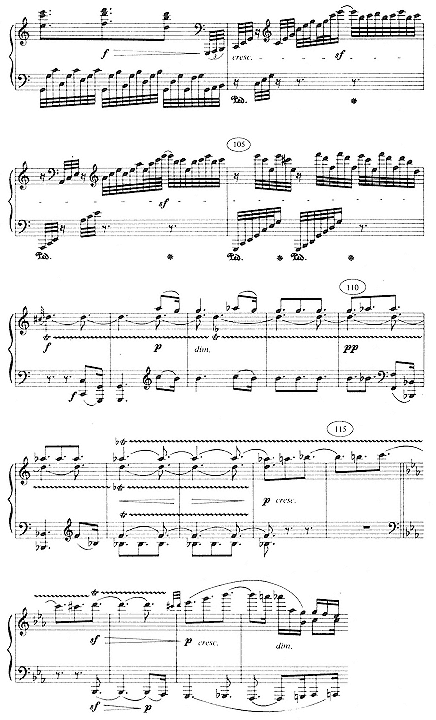
Example 7
Beethoven, Piano Sonata in C Minor,
Op. 111. "Cadenza" to Adagio.
ment, Beethoven told Carl Czerny, inspired by the sight of the starry sky and the thought of the music of the spheres.[49]
With the harmony and periodic rhythm of the arietta in abeyance, the consummatory passage of the Adagio doubles the surging temporality of the Allegro but frees it of all rigidity, rupture, tragic implacability. The ariettalike passage of musical time in a long, continuous arc of melody seems to give dynamic expression to something static in the trills—some all-pervasive presence of the kind that Wordsworth, in a remarkable act of transferred ambivalence, called "The sense of God, or whatso'er is dim/Or vast in [our] own being" (Prelude [1805], 13.72–73). This process culminates in the abrupt, but in no sense discontinuous, blossoming of the triple trill. Here the melody is reduced to a barely audible pulsation on a single pitch: not a contour traced in time, but the naked sound of passing time itself.[50] Like the "one life" that Wordsworth discovered at the apex of his Lake District boyhood, time reveals itself in this passage as a pure or primal music, an originary and ecstatic expressiveness:
I was only then
Contented when with bliss ineffable
I felt the sentiment of being spread
O'er all that moves. . . . Wonder not
If such my transports were, for in all things
I saw one life, and felt that it was joy;
One song they sang, and it was audible,
Most audible then when the fleshly ear . . .
Forgot its functions and slept undisturbed.
(Prelude [1805], 2.418–21, 428–32, 434)
Song: arietta. Both Beethoven and Wordsworth substitute a figurative singing voice, a voice not heard by the ear, for the traditionally inaudible musica mundana . The voice finds its sounding medium in a distinctively Romantic version of musica humana : in "transports," overflows of joyous feeling, that become articulate in and through the rhythms of human time. Thus Wordsworth reinter-
[49] Kirkendale ("New Roads," 188–90) connects the Benedictus with the quartet movement and cites Beethoven's often-quoted remark to Czerny.
[50] For a discussion of such revelations of time, or "chronophanies," in Romantic works, see my Music and Poetry , 225–29.
prets "bliss ineffable" as expressive song; Beethoven restates the simultaneity of the triple trill as the succession of melodic trills—three of them, each with a trilled upbeat. I would not put it past Beethoven to be thinking here in symbolic terms of triads and the Trinity. Given the self-consuming heroism of his Allegro, however, what matters most in the Adagio is something more immediate: an affirmation that the song of passing time is simple, radiant, and—astonishingly—benign.
The trills and their contrapuntal resolution aim at surpassing even the most idyllic mode of normal discourse. This more-than-utopian impulse is what compels the new harmonic color that emerges during the trills and continues through a dozen subsequent measures. The harmony here departs from C major only in order to prolong it with dazzling clarity. The structural purpose of the changing harmony is to defer an important cadence promised by the initial measures of trilling.[51] This deferral is realized as a progressive enrichment, a continuous assimilation of new sonorities in an accelerating harmonic rhythm. The trills establish temporal movement on the harmonic level as a plenitude: the plenitude continues—and expands—even after the trills have resolved. (One can hear in this a structural transcription of the accumulation of melodic dissonances in variations 1–4). The outcome of this process is the reprise of the arietta, which coincides with the long-deferred cadence. The cadence itself is unobtrusive, rhythmically unmarked. Its effect is not to delimit, but to release; not to concenter the musical process that begins with the arietta, but to renew it.
The music that follows is meant to comprehend and affirm this act of renewal. In reprising the arietta, Beethoven also reprises the barely measurable pulsation of the fourth variation; the pulsation continues through a coda that once again floats away into twelve measures of trilling, this time in the tonic. As Rosen suggests, the latter passage forms "a synthesis of all that went before: the rhythmic accompaniment of Variation IV (the fastest measured motion) and the theme in its original form (the slowest) are both suspended under the unmeasured stillness of the trill."[52] The recapitulation of texture and
[51] Tovey, A Companion , 278; Rosen, Classical Style , 447–48.
[52] Rosen, Classical Style , 448.
resolution of harmony resembles the treatment of lyrical counterpoint in the finale of Op. 90, but here the recapitulation is more like a vivid memory, or even a metaphor, than like a new revelation. The harmony itself carries a secondary feeling. The earlier enhanced sonority is structurally dissonant, but its illocutionary force is to mirror a transcendent consonance. Like Wordsworth's spots of time, the consummatory passage is a nonpareil, recoverable only at a distance, in displaced forms. As the final trills draw to a close, a famous pair of exposed C-C

The final trills have greater rhythmic definition than their earlier counterparts, but they are more than supple enough to consolidate the rhythmic work of the Adagio. In the secondary climax that the final trills provide, the expressive doubling of the Allegro's temporal character assumes a structurally stable form. As we know, the Allegro follows an irregular course set by the diminished-seventh aggregate. We might surmise, accordingly, that in doubling the irregularity Beethoven would also double the structural use of the aggregate. Diminished-seventh sonority is quite alien to the arietta: what role might it have as the variations proceed?
One answer is that a mere scarcity of diminished-seventh chords is refreshing after a movement rife with them; but more is at stake here than simple contrast. As Cooper and others have noted, the arietta and the first two variations form a continuous group. "Here," writes Cooper, "the music at first flows smoothly and then with a regular, gently dotted rhythm; and there are no forte . . . markings." With the third variation, "the mood changes suddenly. . . . If the mood of this variation is violent, it is a violent joy, a stamping dance of triumph."[53] As a sign of that triumph, Beethoven abruptly seizes upon the entire diminished-seventh aggregate and works it into the A section of the dance, where it adds a rather wicked insouciance to the general exhilaration (Example 8). The aggregate thus appears as what Bakhtin calls a "gay monster," a travesty of something terrifying by which carnivalesque jubilation casts all terror out.[54]
In the third variation, the contorted energy of the Allegro finds a
[53] Cooper, Beethoven , 201.
[54] Bakhtin, Rabelais , 91, 197.
catharsis, an explosive release from the struggle for heroic mastery. The antinomian festivity of this music, however, is in some ways as contorted as the Allegro itself. Its creative energy is too hard to separate from sublimated aggressiveness—a familiar problem in Romantic illocutions. The inspired figure at the close of Coleridge's "Kubla Khan" can serve as a literary parallel:
And all should cry, Beware! Beware!
His flashing eyes, his floating hair!
Weave a circle round him thrice,
And close your eyes with holy dread,
For he on honey-dew hath fed,
And drunk the milk of Paradise.
(49–54)
Gay monster or not, the diminished-seventh aggregate is still a source of blatant rupture here—so much so that the B section of the dance closes its eyes in holy dread and excludes all but a single fleeting appearance of Dm7-1. Nonetheless, certain terms have been set. The aggregate will be heard from again, and in music that will be called upon to reinterpret rupture as an image of transcendence.
The fourth variation resumes the serene unfolding of the movement. Here again, the A section sets forth the diminished-seventh aggregate, this time in the spirit of transferred ambivalence; stated and resolved off the beat, the chords ripple the flow of the music like stones lightly tossed in a stream. The diminished sevenths have a stronger, more lingering presence here than they do in the third variation, and some of their resolutions recall the resolution structure of the Allegro. As the music reaches the critical threshold between measured and unmeasured pulsation, its expressive doubling of the Allegro becomes richer, more explicit, more durable. Yet the reconciliation between the diminished-seventh sonority and the murmuring rapture of the music is also incomplete. In the fourth variation, the two halves of the theme are not simply repeated; they are varied further in the pattern AA¢ BB¢ , with AB and A¢ B¢ in melodic parallel. In the A section, the full aggregate appears, but in the parallel B section, Dm7-3 is missing and Dm7-1 fails to resolve. More time must pass, or time pass differently, before the sonority of the variations can fully embrace a chromatic saturation by diminished-
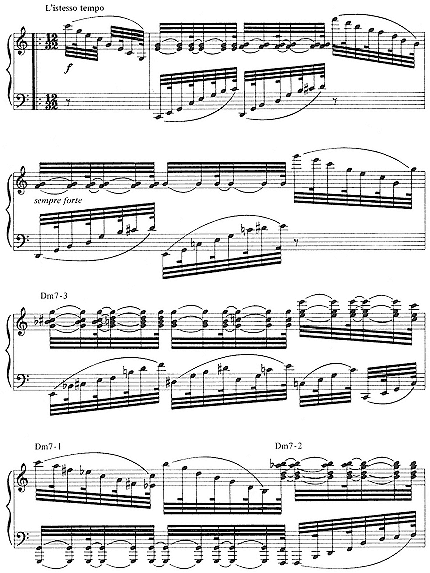
Example 8
Beethoven, Piano Sonata in C Minor, Op. 111. Adagio: beginning of Variation 3.
seventh chords. Like a Bildungsgeschichte , the archetypally Romantic narrative of the self-education of consciousness, the musical process must find its way step by step.[55]
But the final steps are not far off. Following variation 4 the resolution of the consummatory trills leaves the music on the tonal plateau of




In the aftermath of its consummation, then, the Adagio transfigures the diminished-seventh aggregate in the fullest possible terms. The final expressive doubling both incorporates and resolves the C-minor tonality in which the aggregate formed the nerve center of conflicting forces—turbulence and control, impulsiveness and rigidity. In turning to C minor, the Adagio reveals a previously unacknowledged gap in its effort to sublimate the tensions of the Allegro. In filling that gap, however, the C-minor music acts as a "plenitude enriching another plenitude"; it completes the harmonic enrichment of C major that originates during the trills. This is just the mode of ambivalence that Derrida calls the logic of the supplement.[56] And it is just this music of the supplement from which the arietta re-emerges in its original form, but supplemented in its own right by the accompaniment that pulses beneath it.
The espressivo passage reveals itself fully only in detail. On its three previous appearances in the Adagio, the diminished-seventh aggregate has been stated asymmetrically, and in successions unrelated to
[55] On the successive stages of Romantic Bildung , see Abrams, Natural Supernaturalism , 187–95.
[56] Derrida, Of Grammatology , 144–45.
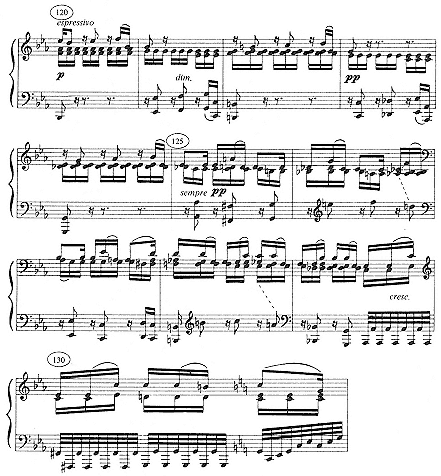
Example 9
Beethoven, Piano Sonata in C Minor, Op. 111. Espressivo passage of Adagio.
the order of the chords established in the Allegro. On this occasion, however, the chords form a balanced pair of couplets, beginning with Dm7-3, the chord that disappeared from the fourth variation:
|
|
The breaking up of the second chord in each couplet suggests a final end to conflict. In each case, the fragmentary chord is completed (and confirmed in its identity) by the chord following, the two together filling out a strangely consoling dominant minor-ninth. It is as if the aggregate were dissolving, blending into the "one song" all around it. Concurrently, the chords of the aggregate once more form a meaningful succession—the retrograde of their order in the Allegro. Even the earlier resolution structure (with changes of mode) returns in retrograde, each resolution set within the second beat of the measure: Dm7-3 resolves to IV, Dm7-2 twice progresses to I, and Dm7-1 begins (and frames) the final precadential progression to V. It is as if the emotional and structural violence of the Allegro were being undone, worked through in the Freudian sense, piece by piece. Each wound receives its balm, last to first, until a pristine motion and harmony—those of the arietta—are restored.
Perhaps the most important point that can be made about this restoration is that it leads to a chain of others. The reprise of the arietta overlaps into a free variation that combines the arietta's signature rhythm with the unforced rhythmic animation that doubles the animation of the Allegro (mm. 146–59). This in turn evolves into the reprise of the consummatory trills, which is also a second reprise of the arietta. The trilled reprise even leads to a miniature fantasy on the B section of variation 4 en route to the closing passage.
This chain of reprises can be understood both affirmatively and critically in relation to the program of Romantic esthetics. The utopian Bildungsgeschichte typically identifies its goal as the repossession and sublimation of a blissful origin. The origin, accordingly, achieves its originary value only when it is also an end, "comprehended essentially as result," in Hegel's phrase.[57] Beethoven exemplifies this type of return in the finale of his Piano Sonata in E Major, Op. 109, a set of variations that closes, after a long chain of trills,
[57] Hegel's formulation appears in the Preface to his Phenomenology of Mind ; the concept is one of the most widespread of the era. For discussion, see Abrams, Natural Supernaturalism , 179–187, 199–292. It should be noted, however (and often has been), that Abrams's account is insufficiently distanced from the concepts it addresses.
with an essentially literal reprise of its cantabile theme. In what may be a pointed contrast, the Adagio of Op. 111 ends by fragmenting the signature rhythm of the arietta—ends, that is, by undoing its origin. The Adagio defers a cyclical close on the model of Op. 109 in favor of a generalized, heterogeneous movement of reorigination. The effect is best conveyed by recalling once more Beethoven's 1815 diary entry: "I returned . . . to the elevated and pure source, to the God-head. —And, to your art." One reprise entails another; no source is the source.
In large-scale terms, the recurrence of the diminished-seventh aggregate in the Adagio of Op. 111 can be said to find its extended resolution in the chain of reprises. This resolution coalesces with the exaltation of note motion that impels the series of variations; the "almost undifferentiated pulsation" that resumes with the reprise of the arietta continues unabated thereafter, ceasing only with the onset of the closing passage.
The cultural implications of this structure are highly charged. Romantic utopianism has been attacked by twentieth-century critics for harboring a latent absolutism. The argument runs that utopian esthetics can too easily be perverted into an "esthetic ideology" that is complicit with repressive and even totalitarian attitudes.[58] The esthetic ideology seeks to establish purity and elevation by repressing difference, heterogeneity, discontinuity. The results can be stifling for art; for history and society, they can be calamitous. The Adagio of Op. 111, however, with its thorough and rigorous traversal of the diminished-seventh aggregate, its heterogeneous chain of reprises, suggests that at least one version of Romantic utopianism is critical or vigilant enough to forestall the esthetic ideology. Far from repressing difference, the music insists on difference, and in so doing constitutes an implicit critique of the ideological tendency that may taint the utopian impulse.[59]
[58] For discussion, see Jonathan Culler, "'Paul de Man's War' and the Aesthetic Ideology," Critical Inquiry 15 (1989): 777–83. Richard Taruskin's "Resisting the Ninth," 19th-Century Music 12 (1989): 214–56, raises similar issues in specific connection with Beethoven's Ninth Symphony. The Ninth is a crux of particular importance for Romantic utopianism, because its vehicle of progress is joy, a category (to use the psychoanalytic dualism) of pleasure rather than of reality.
[59] For more on Beethoven's utopianism, see Solomon, Beethoven , 309–16, and Beethoven Essays , 214–15, 221–22.
A similar mixture of affirmation and critique can be taken to extend to utopian desire itself. The weight of diminished-seventh sonority in Beethoven's Adagio suggests that the desired "sentiments of inner peace" may be merely cherished illusions, even escapist illusions. Many of the works considered in this chapter find means to suggest the same thing: the easily shattered reflection of the ram in Wordsworth's "peaceful flood", the delicate lyrical counterpoint in the Rondo of Op. 90, the wind-blown images in Shelley's forest pool. There exists, indeed, an extended family of Romantic images in which the realization of desire all but coincides with the repression of disappointment. I have in mind those images of suspended loss, of deferred privation, that so often articulate moments of fullness in Romantic literature:
Who hath not seen thee oft amid thy store?
Sometimes whoever seeks abroad may find
Thee sitting careless on a granary floor,
Thy hair soft-lifted by the winnowing wind . . .
Or by a cyder-press, with patient look,
Thou watchest the last oozings hours by hours.
(Keats, "To Autumn," 12–15, 21–22)
Grant me a single summer, you lords of all,
A single autumn, for the fullgrown song,
So that, with such sweet playing sated,
Then my heart may die more willing.
(Hölderlin, "To the Fates," 1–4)
Four years and thirty, told this very week,
Have I been now a sojourner on earth,
And yet the morning gladness is not gone
Which then was in my mind.
(Wordsworth, Prelude [1805], 6.61–64)
Images like these implicitly acknowledge that the process of idealization, the one indispensable element in all expressive doubling, all utopian esthetics, is an effect of desire before it is an effect of knowledge. The result is that the images demystify themselves in the very act of satisfying their audience—or, rather, they satisfy in the very act of demystification. To use the language of Paul de Man, as rhetoric these images mask loss as a metaphor of fullness, while as
reference they arrest—but not indefinitely—the moment of loss.[60] Either way, their force is to preserve the possibility of idealization by giving disappointed desire the wherewithal to continue.
[60] See Paul de Man, "Intentional Structure of the Romantic Image," in The Rhetoric of Romanticism (New York, 1984), 1–18.
